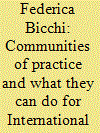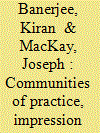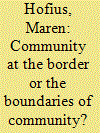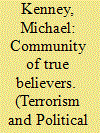|
|
|
Sort Order |
|
|
|
Items / Page
|
|
|
|
|
|
|
| Srl | Item |
| 1 |
ID:
183700


|
|
|
|
|
| Summary/Abstract |
This article argues that communities of practice (CoPs) provide IR with a unique way to understand how a small group of committed people can make a difference to international politics. The point is addressed in three steps. First, the article advances our understanding of how CoPs work. While at its core a CoP is a group of people brought together by a practice they enjoy, a CoP also shares a sense of timing, placing, and humour. These aspects help the group anchor, refine, and innovate their practice in the face of challenges and uncertainty. Second, the article contrasts the analysis of CoPs with other IR approaches, especially institutional analysis, network analysis, and epistemic communities, to show how CoPs supplement them. Third, the article illustrates the argument with the example of the EU foreign policy towards the Israeli-Palestinian conflict. It concludes by suggesting that a CoP's perspective not only helps IR better understand informal politics, but also opens up conversations across disciplines.
|
|
|
|
|
|
|
|
|
|
|
|
|
|
|
|
| 2 |
ID:
175553


|
|
|
|
|
| Summary/Abstract |
Military attachés and wartime observers have received surprisingly little attention in international relations. Why do states exchange attachés, permitting uniformed foreigners to gather intelligence on their territory and during their wars? To explain, we adopt a broadly practice-theoretic approach, focusing on the individuals who developed the role by living it, showing how they both innovated a distinct military practice and established institutional legitimacy for attachés. We address an early historical case in which the practice proliferated: the Russo-Japanese War, throughout which observers represented multiple European states, on both sides of the conflict. Sometimes termed the first modern war, the conflict saw Japan's entry into the Eurocentric great power system. In this context, embedded attachés had a dual effect. On the one hand, a professional attaché community established itself: we show how local innovation by embedded officers, in the context of this structurally destabilising event, permitted the creation of a new institutional role that might otherwise have been impossible. On the other, the Japanese made use of the attachés as witnesses for Western governments, observing their performance of great power-hood, as they defeated Russia. The argument has implications for understanding both the military attaché system and communities of practice as such.
|
|
|
|
|
|
|
|
|
|
|
|
|
|
|
|
| 3 |
ID:
148792


|
|
|
|
|
| Summary/Abstract |
This article contributes to the communities of practice (CoP) literature by focusing on the neglected role of the boundary in constructing community. It takes issue with advocates of International Relations’ (IR) most recent ‘practice turn’ who have overrated inclusive practices of linking to the detriment of taking account of exclusive practices of demarcation. A conceptual turn to the boundary, understood as a ‘site of difference’, highlights how the two sets of practices operate simultaneously in creating shared senses of belonging to a community. The article empirically probes this turn to the boundary by studying how the postmodern community of the European Union (EU) is (re)constructed by EU diplomats in its neighbouring state Ukraine. As a borderland, it symbolises an interstitial zone of high connectivity where the EU’s otherwise latent order is unearthed. A reconstructive analysis of interviews with members of this ‘community of practice’ reveals that they function as ‘boundary workers’ who engage in both boundary-spanning and boundary-drawing practices on an everyday basis. Zooming in on the ‘boundary work’ by EU diplomats exposes the complex process of community-building and thereby helps grasp community as an emergent structure of possibilities whose meaning is contextually mediated by its members’ social experience of the boundary.
|
|
|
|
|
|
|
|
|
|
|
|
|
|
|
|
| 4 |
ID:
172170


|
|
|
|
|
| Summary/Abstract |
This paper applies the concept of “communities of practice” to al-Muhajiroun (“the Emigrants”), an outlawed activist network that seeks to create an Islamic caliphate in Britain and the West through activism and proselytizing. Responding to recent studies on terrorism learning and adaptation, the author argues that focusing exclusively on the outputs of learning is unsatisfactory. Instead scholars should analyze learning as a process and unpack the causal mechanisms behind it. To support his within-case analysis, the author draws on extensive field work, including interviews and ethnographic observation. Newcomers to al-Muhajiroun learn the community’s norms and practices through repeated interactions with more experienced activists. These interactions take place in study circles and through companionship. Activists also learn by doing, preaching the Emigrants’ Salafi-Islamist ideology at da’wah stalls and protesting against the West’s “war on Islam” at demonstrations. The more they do, the better they become at performing the network’s high-risk activism, and the more deeply committed they become to its community of practice. However, far from allowing activists to adapt seamlessly to all challenges, the Emigrants’ insular and dogmatic community of practice creates its own problems, hindering its ability to innovate, expand, and thrive in an increasingly hostile environment.
|
|
|
|
|
|
|
|
|
|
|
|
|
|
|
|
| 5 |
ID:
082701


|
|
|
|
|
| Publication |
2008.
|
| Summary/Abstract |
This article invokes a combination of analytical and normative arguments that highlight the leading role of practices in explaining the expansion of security communities. The analytical argument is that collective meanings, on which peaceful change is based, cognitively evolve - i.e. they are established in individuals' expectations and dispositions and they are institutionalized in practice - because of communities of practice. By that we mean like-minded groups of practitioners who are bound, both informally and contextually, by a shared interest in learning and applying a common practice. The normative argument is that security communities rest in part on the sharing of rational and moral expectations and dispositions of self-restraint. This thesis is illustrated by the example of the successful expansion of security-community identities from a core of North Atlantic Treaty Organization (NATO) states to Central and Eastern European countries during the 1990s, which was facilitated by a `cooperative-security' community of practice that, emerging from the Helsinki Process, endowed NATO with the practices necessary for the spread of self-restraint.
|
|
|
|
|
|
|
|
|
|
|
|
|
|
|
|
|
|
|
|
|